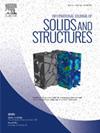Modelling the impact-damage behaviour of composite sandwich panels with functionally-graded TPMS-latticed cores
IF 3.4
3区 工程技术
Q1 MECHANICS
International Journal of Solids and Structures
Pub Date : 2025-06-18
DOI:10.1016/j.ijsolstr.2025.113534
引用次数: 0
Abstract
Advances in 3D printing technology have driven the digital design of multifunctional lattice structures for use in sandwich panel applications. However, understanding the intrinsic relationship between lattice-core topological features, especially when functionally graded, and impact properties is crucial for designing lightweight sandwich panels. Therefore, this paper simulates the low-energy drop-weight impact behavior of 3D printable sandwich panels composed of a stainless steel 316L sheet-based minimal surface lattice core and Prepreg skin. The study examines how cell size, relative density, topology of the lattice, and control of anisotropy in the core through periodicity gradation influence the low-energy impact-damage behavior of sandwich panels. The results indicate that the impact-damage behavior of sheet-based minimal surface-lattice sandwich panels is highly dependent on the core’s topological features. Notably, controlling anisotropy within the lattice core significantly enhanced the impact properties of the lightweight sandwich panel. Varying the periodicity of the Schwartz Diamond topology to control anisotropy in the lattice core improved the peak load and internal energy-to-maximum penetration ratio of the sandwich panel by 35.2 % and 42.4 %, respectively, for the same average relative density of 20 %. Moreover, combining periodicity gradation and relative density gradation using the same topology minimized damages to the frontal panel, in addition to contributing to 117.4 % and 130.6 % increase in peak load and specific energy absorption of sandwich panels, respectively, alongside a considerable rise in energy dissipation capacity. Furthermore, combining multiple lattice-topology functional gradation techniques proved essential in limiting failure localization and thus, improving the impact-damage tolerance of the sandwich panel. The study highlights the importance of combining various lattice-topology functional grading strategies to control the anisotropy and deformation behaviour of minimal surface lattices under drop-weight impact loads. These findings are crucial for designing high-impact protective and lightweight sandwich panels for diverse engineering applications.
具有功能分级tpms网格芯的复合材料夹层板冲击损伤行为建模
3D打印技术的进步推动了用于夹心板应用的多功能点阵结构的数字化设计。然而,理解晶格核拓扑特征(特别是当功能分级时)与冲击性能之间的内在关系对于设计轻质夹层板至关重要。因此,本文模拟了基于316L不锈钢薄板的最小表面晶格芯和Prepreg蒙皮组成的3D打印夹层板的低能落重冲击行为。该研究考察了单元尺寸、相对密度、晶格拓扑结构以及通过周期性梯度控制芯中的各向异性如何影响夹层板的低能冲击损伤行为。结果表明,基于薄板的最小表面晶格夹层板的冲击损伤行为高度依赖于芯的拓扑特征。值得注意的是,控制晶格芯内的各向异性显著提高了轻质夹层板的冲击性能。在平均相对密度为20%的情况下,通过改变Schwartz金刚石拓扑的周期性来控制晶格核的各向异性,可使夹层板的峰值载荷和内部能量与最大穿透比分别提高35.2%和42.4%。此外,使用相同拓扑结构的周期性梯度和相对密度梯度相结合,除了使夹层板的峰值荷载和比能吸收分别提高117.4%和130.6%外,还能显著提高耗能能力。此外,结合多种晶格拓扑功能梯度技术对限制失效局部化至关重要,从而提高夹层板的冲击损伤容限。该研究强调了结合各种晶格拓扑功能分级策略来控制最小表面晶格在落重冲击载荷下的各向异性和变形行为的重要性。这些发现对于设计用于各种工程应用的高冲击防护和轻质夹层板至关重要。
本文章由计算机程序翻译,如有差异,请以英文原文为准。
求助全文
约1分钟内获得全文
求助全文
来源期刊
CiteScore
6.70
自引率
8.30%
发文量
405
审稿时长
70 days
期刊介绍:
The International Journal of Solids and Structures has as its objective the publication and dissemination of original research in Mechanics of Solids and Structures as a field of Applied Science and Engineering. It fosters thus the exchange of ideas among workers in different parts of the world and also among workers who emphasize different aspects of the foundations and applications of the field.
Standing as it does at the cross-roads of Materials Science, Life Sciences, Mathematics, Physics and Engineering Design, the Mechanics of Solids and Structures is experiencing considerable growth as a result of recent technological advances. The Journal, by providing an international medium of communication, is encouraging this growth and is encompassing all aspects of the field from the more classical problems of structural analysis to mechanics of solids continually interacting with other media and including fracture, flow, wave propagation, heat transfer, thermal effects in solids, optimum design methods, model analysis, structural topology and numerical techniques. Interest extends to both inorganic and organic solids and structures.

 求助内容:
求助内容: 应助结果提醒方式:
应助结果提醒方式:


